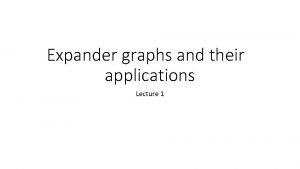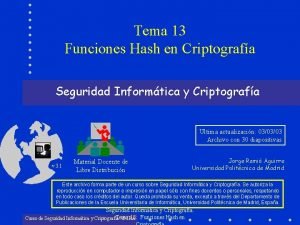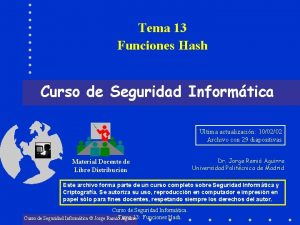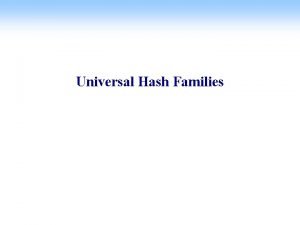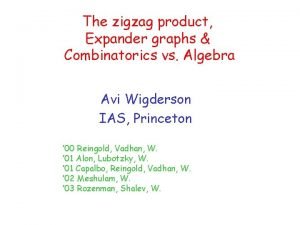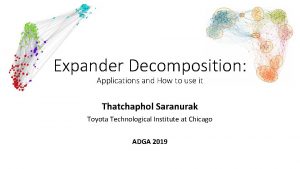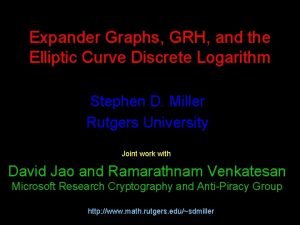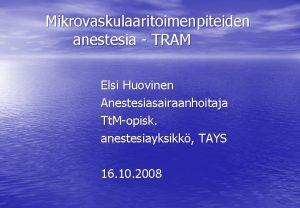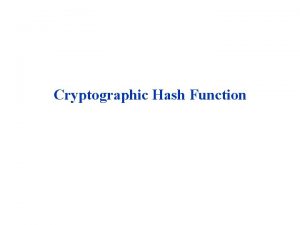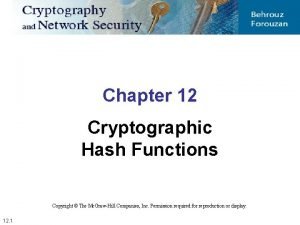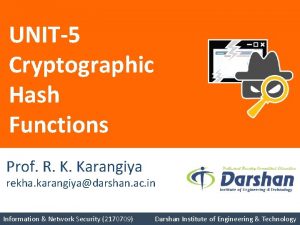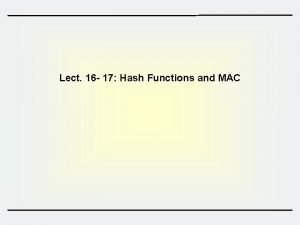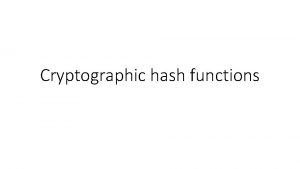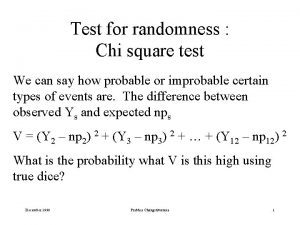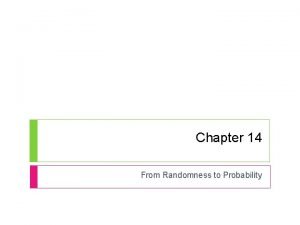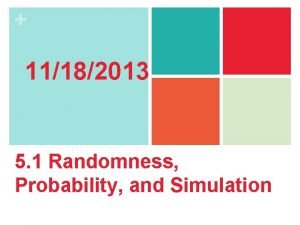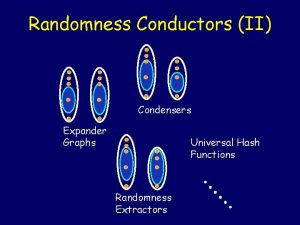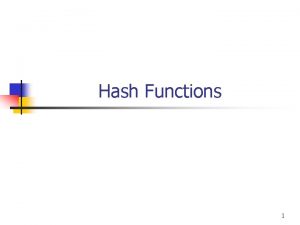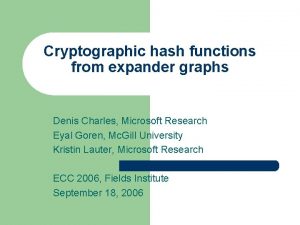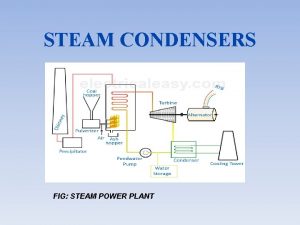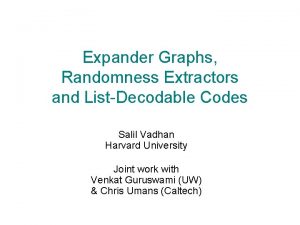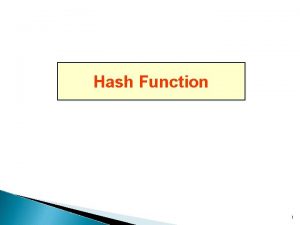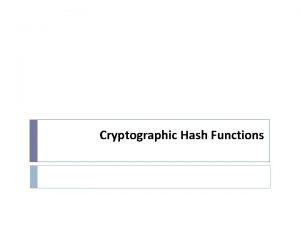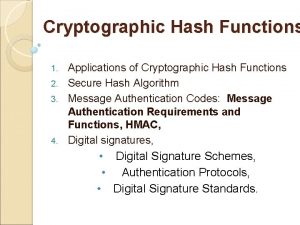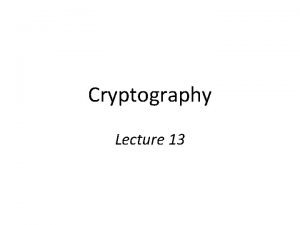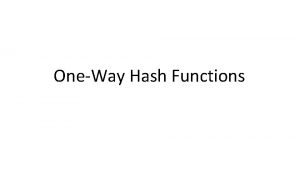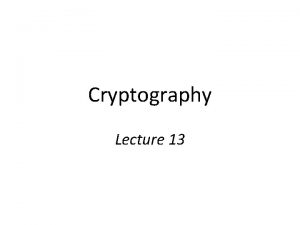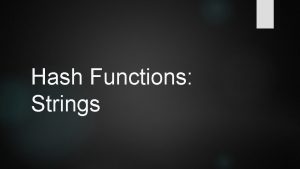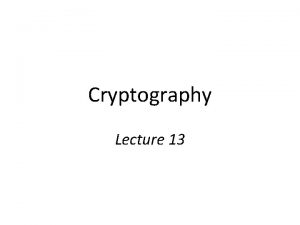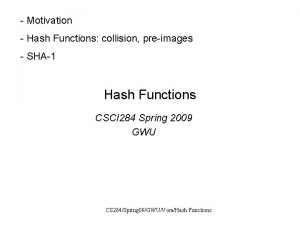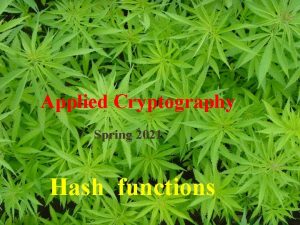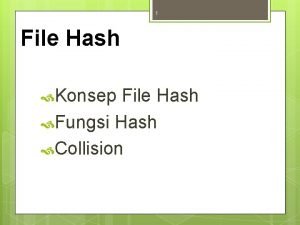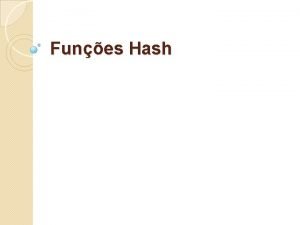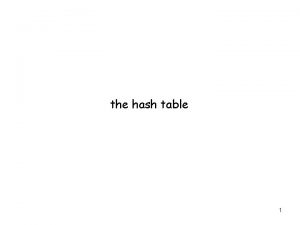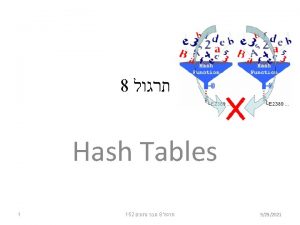Randomness Conductors Condensers Expander Graphs Universal Hash Functions







![Non-blocking Network with On-line Path Selection [ALM] N (Inputs) N (Outputs) Depth O(log N), Non-blocking Network with On-line Path Selection [ALM] N (Inputs) N (Outputs) Depth O(log N),](https://slidetodoc.com/presentation_image_h2/aa7f010c19e3585e3bc3939c1d3346ba/image-8.jpg)
![Non-blocking Network with On-line Path Selection [ALM] N (Inputs) N (Outputs) Every request for Non-blocking Network with On-line Path Selection [ALM] N (Inputs) N (Outputs) Every request for](https://slidetodoc.com/presentation_image_h2/aa7f010c19e3585e3bc3939c1d3346ba/image-9.jpg)






![Simple Expander Codes [G 63, Z 71, ZP 76, T 81, SS 96] N Simple Expander Codes [G 63, Z 71, ZP 76, T 81, SS 96] N](https://slidetodoc.com/presentation_image_h2/aa7f010c19e3585e3bc3939c1d3346ba/image-16.jpg)
![Simple Decoding Algorithm in Linear Time (& log n parallel phases) [SS 96] N Simple Decoding Algorithm in Linear Time (& log n parallel phases) [SS 96] N](https://slidetodoc.com/presentation_image_h2/aa7f010c19e3585e3bc3939c1d3346ba/image-17.jpg)
![Random Walk on Expanders [AKS 87] x 1 x 0 . . . x Random Walk on Expanders [AKS 87] x 1 x 0 . . . x](https://slidetodoc.com/presentation_image_h2/aa7f010c19e3585e3bc3939c1d3346ba/image-18.jpg)




- Slides: 22

Randomness Conductors Condensers Expander Graphs Universal Hash Functions Randomness Extractors . . .

Randomness Conductors Meta-Definition N Prob. dist. X x M D Prob. dist. X’ x’ An R-conductor if for every (k, k’) R, X has k bits of “entropy” X’ has k’ bits of “entropy”.

Plan Definitions & Applications: • The balanced case (M = N). – Vertex Expansion. – 2 nd Eigenvalue Expansion. • The unbalanced case (M ≪ N). – Extractors, Dispersers, Condensers. Conductors • Universal Hash Functions. Constructions: • Zigzag Product & Loosless Expanders.

(Bipartite) Expander Graphs N S, |S| K N D | (S)| A |S| (A > 1) Important: every (not too large) set expands.

(Bipartite) Expander Graphs N S, |S| K N D | (S)| A |S| (A > 1) • Main goal: minimize D (i. e. constant D) • Degree 3 random graphs are expanders! [Pin 73]

(Bipartite) Expander Graphs N S, |S| K N D | (S)| A |S| (A > 1) Also: maximize A. • Trivial upper bound: A D – even A ≲ D-1 • Random graphs: A D-1

Applications of Expanders These “innocent” objects are intimately related to various fundamental problems: • • Network design (fault tolerance), Sorting networks, Complexity and proof theory, Derandomization, Error correcting codes, Cryptography, Ramsey theory And more. . .
![Nonblocking Network with Online Path Selection ALM N Inputs N Outputs Depth Olog N Non-blocking Network with On-line Path Selection [ALM] N (Inputs) N (Outputs) Depth O(log N),](https://slidetodoc.com/presentation_image_h2/aa7f010c19e3585e3bc3939c1d3346ba/image-8.jpg)
Non-blocking Network with On-line Path Selection [ALM] N (Inputs) N (Outputs) Depth O(log N), size O(N log N), bounded degree. Allows connection between input nodes and output nodes using vertex disjoint paths.
![Nonblocking Network with Online Path Selection ALM N Inputs N Outputs Every request for Non-blocking Network with On-line Path Selection [ALM] N (Inputs) N (Outputs) Every request for](https://slidetodoc.com/presentation_image_h2/aa7f010c19e3585e3bc3939c1d3346ba/image-9.jpg)
Non-blocking Network with On-line Path Selection [ALM] N (Inputs) N (Outputs) Every request for connection (or disconnection) is satisfied in O(log N) bit steps: • On line. Handles many requests in parallel.

The Network N (Inputs) “Lossless” Expander

Slightly Unbalanced, “Lossless” Expanders N S, |S| K M= N D | (S)| 0. 9 D |S| 0< 1 is an arbitrary constant D is constant & K= (M/D) = ( N/D). [CRVW 02]: such expanders (with D = polylog(1/ ))

Property 1: A Very Strong Unique Neighbor Property S, |S| K, | (S)| 0. 9 D |S| S Unique neighbor of S Non Unique neighbor S has 0. 8 D |S| unique neighbors !

Using Unique Neighbors for Distributed Routing Task: match S to its neighbors (|S| K) S S` Step I: match S to its unique neighbors. Continue recursively with unmatched vertices S’.

Reminder: The Network Adding new paths: think of vertices used by previous paths as faulty.

Property 2: Incredibly Fault Tolerant S, |S| K, | (S)| 0. 9 D |S| Remains a lossless expander even if adversary removes (0. 7 D) edges from each vertex.
![Simple Expander Codes G 63 Z 71 ZP 76 T 81 SS 96 N Simple Expander Codes [G 63, Z 71, ZP 76, T 81, SS 96] N](https://slidetodoc.com/presentation_image_h2/aa7f010c19e3585e3bc3939c1d3346ba/image-16.jpg)
Simple Expander Codes [G 63, Z 71, ZP 76, T 81, SS 96] N (Variables) M= N (Parity Checks) 1 0 0 + + 1 +0 1 + Linear code; Rate 1 – M/N = (1 - ). Minimum distance K. Relative distance K/N= ( / D) = / polylog (1/ ). For small beats the Zyablov bound and is quite close to the Gilbert-Varshamov bound of / log (1/ ).
![Simple Decoding Algorithm in Linear Time log n parallel phases SS 96 N Simple Decoding Algorithm in Linear Time (& log n parallel phases) [SS 96] N](https://slidetodoc.com/presentation_image_h2/aa7f010c19e3585e3bc3939c1d3346ba/image-17.jpg)
Simple Decoding Algorithm in Linear Time (& log n parallel phases) [SS 96] N (Variables) Error set B, |B| K/2 1 0 10 |FlipB| |B|/4 01 |BFlip| |B|/4 |Bnew| |B|/2 1 M= N (Constraints) + 0 + 1 | (B)| >. 9 D |B| 1 + 0 | (B) Sat|<. 2 D|B| + 0 • Algorithm: At each phase, flip every variable that “sees” a majority of 1’s (i. e, unsatisfied constraints).
![Random Walk on Expanders AKS 87 x 1 x 0 x Random Walk on Expanders [AKS 87] x 1 x 0 . . . x](https://slidetodoc.com/presentation_image_h2/aa7f010c19e3585e3bc3939c1d3346ba/image-18.jpg)
Random Walk on Expanders [AKS 87] x 1 x 0 . . . x 2 xi xi converges to uniform fast (for arbitrary x 0). For a random x 0: the sequence x 0, x 1, x 2. . . has interesting “random-like” properties.

Expanders Add Entropy N Prob. dist. X x M D Induced dist. X’ x’ • Definition we gave: |Support(X’)| A |Support(X)| • Applications of the random walk rely on “less naïve” measures of entropy. • Almost all explicit constructions directly give “ 2 nd eigenvalue expansion”. • Can be interpreted in terms of Renyi entropy.

nd 2 Eigenvalue Expansion G - Undirected N D Symmetric N N D • P=(Pi, j) - transition probabilities matrix: Pi, j= (# edges between i and j in G) / D • Goal: If [0, 1]n is a (non-uniform) distribution on vertices of G, then P is “closer to uniform. ”

nd 2 Eigenvalue Expansion • 0 1 … N-1, eigenvalues of P. – 0 =1, Corresponding eigenvector v 0 =1 N: P(Uniform)=Uniform – Second eigenvalue (in absolute value): = (G)=max{| 1|, | N-1|} – G connected and non-bipartite <1 – is a good measure of the expansion of G [Tan 84, AM 84, Alo 86]. Qualitatively: G is an expander (G) < β < 1

Randomness Conductors • Expanders, extractors, condensers & hash functions are all functions, f : [N] [D] [M], that transform: X “of entropy” k X’ = f (X, Uniform) “of entropy” k’ • Many flavors: – Measure of entropy. – Balanced vs. unbalanced. – Lossless vs. lossy. – Lower vs. upper bound on k. – Is X’ close to uniform? – … Randomness conductors: As in extractors. Allows the entire spectrum.
 Steam condensers
Steam condensers Expander graphs and their applications
Expander graphs and their applications Tema de hash hash
Tema de hash hash Algoritmo abcde
Algoritmo abcde Degree and leading coefficient
Degree and leading coefficient Hash family
Hash family Expander algebra
Expander algebra Expander decomposition
Expander decomposition Logarithm expander
Logarithm expander Lämpöpatja sänkyyn
Lämpöpatja sänkyyn Breast cancer reconstruction forum
Breast cancer reconstruction forum Transforce appliance
Transforce appliance Two simple hash function
Two simple hash function Davies meyer scheme
Davies meyer scheme Hash functions
Hash functions Hash functions
Hash functions Hash functions
Hash functions Transition bugs in software testing
Transition bugs in software testing Speed and velocity
Speed and velocity Graphs that enlighten and graphs that deceive
Graphs that enlighten and graphs that deceive Chi square test for randomness
Chi square test for randomness Chapter 14 randomness and probability
Chapter 14 randomness and probability Randomness probability and simulation
Randomness probability and simulation

